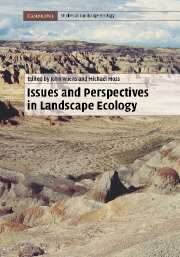Book contents
- Frontmatter
- Contents
- List of contributors
- Preface
- PART I Introductory perspectives
- PART II Theory, experiments, and models in landscape ecology
- PART III Landscape patterns
- PART IV Landscape dynamics on multiple scales
- PART V Applications of landscape ecology
- PART VI Cultural perspectives and landscape planning
- 26 The nature of lowland rivers: a search for river identity
- 27 Using cultural knowledge to make new landscape patterns
- 28 The critical divide: landscape policy and its implementation
- 29 Landscape ecology: principles of cognition and the political–economic dimension
- 30 Integration of landscape ecology and landscape architecture: an evolutionary and reciprocal process
- 31 Landscape ecology in land-use planning
- PART VII Retrospect and prospect
- Index
- Plate section
- References
26 - The nature of lowland rivers: a search for river identity
from PART VI - Cultural perspectives and landscape planning
Published online by Cambridge University Press: 20 November 2009
- Frontmatter
- Contents
- List of contributors
- Preface
- PART I Introductory perspectives
- PART II Theory, experiments, and models in landscape ecology
- PART III Landscape patterns
- PART IV Landscape dynamics on multiple scales
- PART V Applications of landscape ecology
- PART VI Cultural perspectives and landscape planning
- 26 The nature of lowland rivers: a search for river identity
- 27 Using cultural knowledge to make new landscape patterns
- 28 The critical divide: landscape policy and its implementation
- 29 Landscape ecology: principles of cognition and the political–economic dimension
- 30 Integration of landscape ecology and landscape architecture: an evolutionary and reciprocal process
- 31 Landscape ecology in land-use planning
- PART VII Retrospect and prospect
- Index
- Plate section
- References
Summary
Rivers have, more than almost any other unanimated object, an animated gesture, something resembling character
Macaulay (1838) describing the Rhône (see Schama, 1995)River rehabilitation, on what scientific basis?
In doing research on a river, by discovering more and more of its secrets, the observer will come nearer and nearer to its identity. Every river ecologist has his or her favorite river mainly because of its character. This individual character or identity, however, is difficult to translate into scientific terms. Since we are educated to mistrust our subjectivity in science, personal impressions are generally kept for artists and general conversation. Can river identity be approached in a more objective way by making use of objective personal impressions?
In integrated river management in western Europe, scientific, technological, and political developments have led to an understanding that the immense social chances and constraints related to river management should be approached in a systematic and interactive way. A clear delineation of rehabilitation targets for nature should enhance unbiased public and scientific discussion of these opportunities and constraints. The aim of this essay is to explore the scientific dimension of river rehabilitation and to survey the possibility of using personal impressions as an instrument to approach river identity. The main focus is on lowland rivers, as illustrated by the Meuse.
River rehabilitation commonly aims at increased biodiversity or improved connectivity. Biodiversity, as such, has no meaning unless it is related to a coherent network of habitats.
- Type
- Chapter
- Information
- Issues and Perspectives in Landscape Ecology , pp. 259 - 273Publisher: Cambridge University PressPrint publication year: 2005
References
- 2
- Cited by



